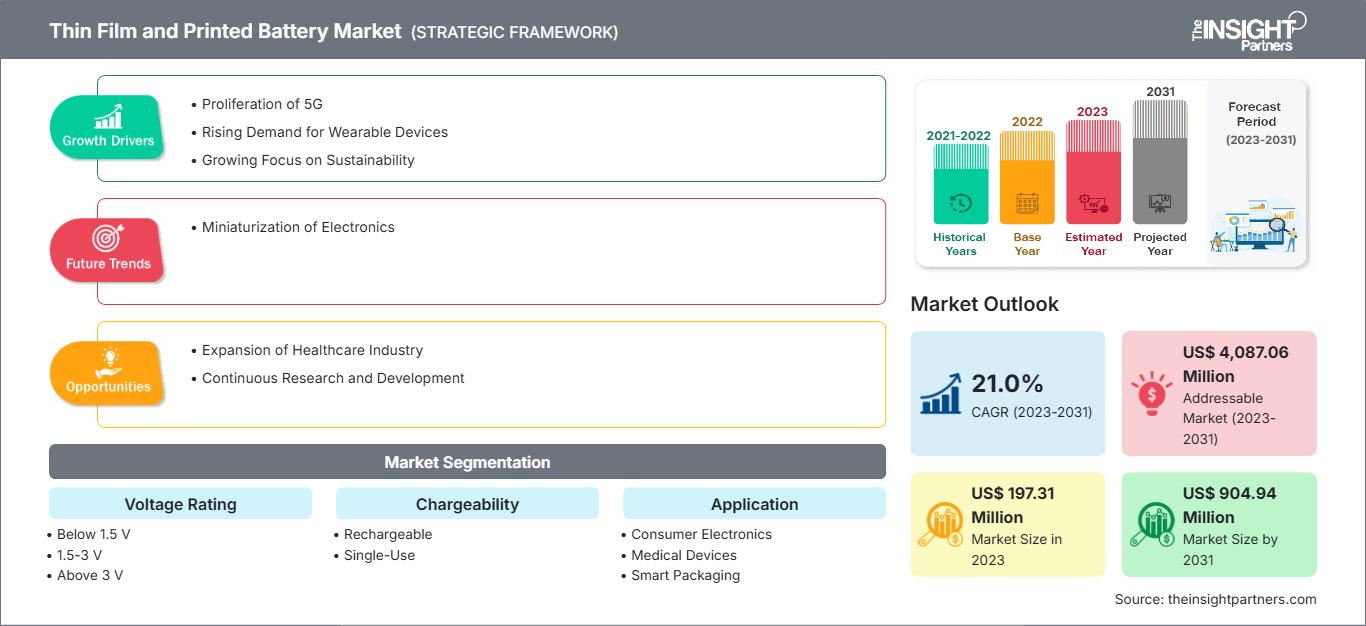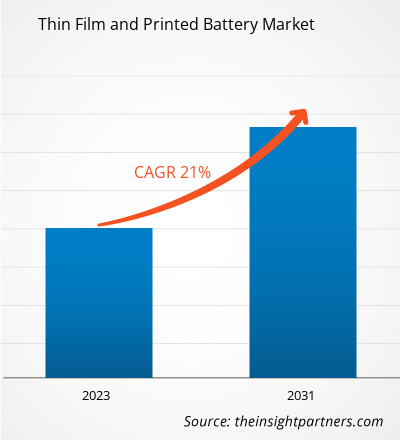Der Markt für Dünnschicht- und gedruckte Batterien soll von 197,31 Millionen US-Dollar im Jahr 2023 auf 904,94 Millionen US-Dollar im Jahr 2031 anwachsen. Für den Zeitraum 2023–2031 wird ein durchschnittliches jährliches Wachstum (CAGR) von 21,0 % erwartet. Die Miniaturisierung von Elektronik dürfte ein wichtiger Markttrend bleiben.
Marktanalyse für Dünnschicht- und gedruckte Batterien
Dünnschichtbatterien werden aufgrund ihrer verbesserten Laderate und geringen Größe zunehmend in Fitnessarmbändern, Smartwatches, Headsets und anderen tragbaren elektronischen Geräten eingesetzt. Auch die zunehmende Verbreitung von 5G erhöht die Nachfrage nach vernetzten elektronischen Geräten. Darüber hinaus treibt die zunehmende Verwendung von Smartcards, wie z. B. der EMV-Chipkartentechnologie, die Nachfrage nach Dünnschicht- und gedruckten Batterien weltweit an. Da Chipkarten bei hohen Temperaturen von 130–150 Grad Celsius hergestellt werden, wodurch die organischen Bestandteile herkömmlicher Batterien zersetzt werden und ihre Funktion beeinträchtigt wird, steigt die Nachfrage nach Dünnschicht- und gedruckten Batterien für die Produktion von Chipkarten. Darüber hinaus wird erwartet, dass die zunehmende Miniaturisierung elektronischer Geräte im Prognosezeitraum Wachstumschancen für den Markt für Dünnschicht- und gedruckte Batterien schafft.
Marktübersicht für Dünnschicht- und gedruckte Batterien
Dünnschichtbatterien sind Festkörperbatterien mit Größen von Nanometern bis Millimetern. Sie bestehen aus einer Anode, einer Kathode, einem Elektrolyten und einem Separator. Dünnschicht-Lithium-Ionen-Batterien sind leistungsfähiger als herkömmliche Lithium-Ionen-Batterien, da sie eine höhere durchschnittliche Ausgangsspannung, ein geringeres Gewicht, eine höhere Energiedichte, eine längere Lebensdauer und eine Funktionsfähigkeit bei Temperaturen von -20 °C bis 60 °C aufweisen. Diese Batterien werden in einer Vielzahl von Anwendungen eingesetzt, darunter Smartcards, drahtlose Sensoren, Laptops, Touchscreens, astronomische Spiegel, RFID-Tags, Photovoltaik-Energieerzeugung und -speicherung sowie implantierbare Geräte.
Passen Sie diesen Bericht Ihren Anforderungen an
Sie erhalten kostenlos Anpassungen an jedem Bericht, einschließlich Teilen dieses Berichts oder einer Analyse auf Länderebene, eines Excel-Datenpakets sowie tolle Angebote und Rabatte für Start-ups und Universitäten.
Markt für Dünnschicht- und gedruckte Batterien: Strategische Einblicke

-
Holen Sie sich die wichtigsten Markttrends aus diesem Bericht.Dieses KOSTENLOSE Beispiel umfasst Datenanalysen, die von Markttrends bis hin zu Schätzungen und Prognosen reichen.
Treiber und Chancen für den Markt für Dünnschicht- und gedruckte Batterien
Aufkommen von 5G treibt Wachstum für den Markt für Dünnschicht- und gedruckte Batterien
Das 5G-Netz ist etwa 100-mal schneller als das 4G-Netz und erleichtert so die Datenerfassung in Echtzeit. Da das 5G-Netz eine starke Konnektivität und Hochgeschwindigkeitsdatenübertragung bietet, steigt die Nachfrage danach weltweit. Laut der Groupe Speciale Mobile Association (GSMA) wird die globale 5G-Durchdringung voraussichtlich von 17 % im Jahr 2022 auf 54 % im Jahr 2030 steigen. Nordamerika verzeichnete die höchste 5G-Durchdringung mit 39 % im Jahr 2022; bis 2030 soll sie 91 % erreichen. Die 5G-Durchdringung im asiatisch-pazifischen Raum (außer China) und Europa wird voraussichtlich von 4 % bzw. 11 % im Jahr 2022 auf 41 % bzw. 87 % im Jahr 2030 steigen. Da 5G die entscheidende Netzwerktechnologie der neuen Generation ist, die Innovationen ermöglichen und die digitale Transformation unterstützen kann, steigt die Nachfrage danach weltweit. Daher investieren die Regierungen verschiedener Länder in die 5G-Infrastruktur. Im Juli 2021 kündigte die französische Regierung an, bis 2025 über öffentliche und private Investitionen rund 2,06 Milliarden US-Dollar (1,7 Milliarden Euro) in ihren 5G-Markt zu investieren. Dadurch will die Regierung die Entwicklung von 5G im Land beschleunigen. Ebenso kündigte die südkoreanische Regierung im Januar 2021 an, die Abdeckung der Mobilfunknetze der nächsten Generation, insbesondere 5G, in diesem Jahr von derzeit sieben Großstädten auf 85 Städte zu erhöhen. Sie investierte 2021 rund 115,89 Millionen US-Dollar (127,9 Milliarden KRW), um die Nutzung privater 5G-Netze zu fördern. Mit der zunehmenden weltweiten Verbreitung von 5G steigt die Nachfrage nach vernetzten elektronischen Geräten und treibt das Wachstum des Marktes für Dünnschicht- und gedruckte Batterien voran.
Kontinuierliche Forschung und Entwicklung
Aufgrund des zunehmenden Fokus auf Nachhaltigkeit konzentrieren sich die Forscher auf die Entwicklung effizienter Batterietechnologie, die umweltfreundlich hergestellt werden kann und Merkmale wie erhöhte Sicherheit, schnellere Ladezeiten, Toleranz gegenüber hohen Temperaturen und Feuerfestigkeit aufweist. Sie legen Wert darauf, während des Produktionsprozesses von Dünnschicht- und gedruckten Batterien keine giftigen Lösungsmittel zu verwenden. Darüber hinaus konzentrieren sie sich stärker auf die Entwicklung von Batterien, die effizienter sind als Lithium-Ionen-Batterien. Daher suchen sie nach Investoren, die die erforderlichen Mittel für die Forschung und Entwicklung solcher Batterien bereitstellen können. Sie planen, diese auf den Markt zu bringen, um die Nachfrage nach effizienten Batterielösungen für Anwendungen wie tragbare Geräte, Smartcards, Elektronik und RFID-Tags zu bedienen. So gab beispielsweise BTRY, eine Ausgliederung der Eidgenössischen Materialprüfungs- und Forschungsanstalt (Empa) im Kanton Zürich, im September 2023 bekannt, die kommende Generation der Batterietechnologie mit einer innovativen Dünnschichtbatterie vorantreiben zu wollen. Empa-Forscher entwickelten eine Festkörperbatterie auf Basis von Lithiummetall. Damit können sie die Dünnschichtzellen übereinander stapeln, um die Speicherkapazität zu erhöhen.
Das Herstellungsverfahren orientiert sich an der Vakuumbeschichtung, die bei der Produktion von Halbleiterchips verwendet wird. BTRY sucht zudem Investoren für administrative und technische Verbesserungen, um die Technologie auf den Markt zu bringen. Dazu gehört auch, die Batterieprototypen größer und leistungsfähiger zu machen. Daher wird erwartet, dass derartige Forschung und Entwicklung für die fortschrittliche Batterielösung zu ihrer Markteinführung beiträgt, was durch ihre breite Akzeptanz weitere Wachstumschancen für den Markt für Dünnschicht- und gedruckte Batterien schafft.
Segmentierungsanalyse des Marktberichts für Dünnschicht- und gedruckte Batterien
Schlüsselsegmente, die zur Ableitung der Marktanalyse für Dünnschicht- und gedruckte Batterien beigetragen haben, sind Nennspannung, Veränderbarkeit und Anwendung.
- Basierend auf der Nennspannung ist der Markt für Dünnschicht- und gedruckte Batterien in unter 1,5 V, 1,5–3 V und über 3 V unterteilt. Das Segment unter 1,5 V hatte 2023 den größten Marktanteil. Aufgrund ihrer niedrigen Ausgangsspannung sind Dünnschichtbatterien unter 1,5 V für Niederspannungsanwendungen geeignet. Diese Batterien werden hauptsächlich in tragbaren elektronischen Geräten wie Fernbedienungen, Taschenlampen und Spielzeugen verwendet.
- In Bezug auf die Aufladbarkeit ist der Markt in wiederaufladbare und Einwegbatterien segmentiert. Das Segment der wiederaufladbaren Batterien hatte 2023 einen größeren Marktanteil. Die jüngste Forschung und Entwicklung hin zu intelligenteren Gesellschaften im Jahr 2023 machte die Integration intelligenter Geräte mit verbesserter Sicherheit, spezifischer Energie, Leistung und Materialien mit reduzierter Größe erforderlich. Dies hat zu einer steigenden Nachfrage nach wiederaufladbaren Dünnschichtbatterien zur Speicherung elektrischer Energie mit guter Energie- und Leistungsdichte, mechanischer Festigkeit, guter und langer Zyklenlebensdauer und nennenswerter Temperaturtoleranz für kleine tragbare Unterhaltungselektronik geführt, insbesondere in Mobiltelefonen, mobilen Anwendungen, Laptops und Notebooks, Chipkarten, für Elektroautos, Kommunikations- und andere elektrische Geräte.
- In Bezug auf die Anwendung ist der Markt in Unterhaltungselektronik, medizinische Geräte, intelligente Verpackungen, Chipkarten, drahtlose Sensoren und andere segmentiert. Das Segment der Unterhaltungselektronik hatte 2023 den größten Marktanteil. Insbesondere flexible Dünnschichtbatterien haben auch im Bereich der Unterhaltungselektronik oder Wearables großes Potenzial. Aufgrund ihrer anpassungsfähigen Form und Robustheit können sie perfekt in elektronische Geräte integriert werden und als Energiequelle dienen.
Geografische Marktanteilsanalyse für Dünnschicht- und gedruckte Batterien
Der geografische Umfang des Marktberichts für Dünnschicht- und gedruckte Batterien ist hauptsächlich in fünf Regionen unterteilt: Nordamerika, Asien-Pazifik, Europa, Naher Osten und Afrika sowie Süd- und Mittelamerika.
Der Markt in Nordamerika erlebt aufgrund des zunehmenden Trends zur Miniaturisierung in der Unterhaltungselektronik ein beträchtliches Wachstum. Da die Verbraucher nach kleineren und tragbareren elektronischen Geräten suchen, steigt der Bedarf an kompakten und leistungsfähigen Stromquellen. Darüber hinaus ist die Verbreitung von IoT und intelligenten Geräten ein weiterer entscheidender Faktor, der den Markt in Nordamerika antreibt. Die zunehmende Einführung von IoT-Geräten in Branchen wie dem Gesundheitswesen, dem Transportwesen und Smart-Home-Anwendungen schafft enorme Chancen für Hersteller von Dünnschicht- und gedruckten Batterien in der Region. Darüber hinaus ist die Präsenz von Marktteilnehmern wie Molex LLC; Excellatron Solid State, LLC; Ultralife Corporation; und Imprint Energy fördert den Markt für Dünnschicht- und gedruckte Batterien in Nordamerika.
In Europa führen verschiedene Anwendungen von Dünnschicht- und gedruckten Batterien, wie z. B. Chipkarten, intelligente Verpackungen, medizinische Geräte und Unterhaltungselektronik, das Marktwachstum an. Marktteilnehmer wie Varta AG, Ilika, RENATA SA und STMicroelectronics verfolgen verschiedene organische und anorganische Strategien, um ihren Umsatz zu steigern. Die Ausbreitung des Marktes für Unterhaltungselektronik in der Region hat die Nachfrage nach flexiblen Batterielösungen stark ansteigen lassen. Die wachsende Nachfrage nach intelligenten Verpackungslösungen in der Region wird voraussichtlich eine enorme Chance für das Wachstum des Marktes für Dünnschicht- und gedruckte Batterien bieten. Darüber hinaus konzentrieren sich die Forscher in der Region auf die Einführung innovativer Batterielösungen, die zum Wachstum des Marktes für Dünnschicht- und gedruckte Batterien beitragen.
Im asiatisch-pazifischen Raum konzentrieren sich Volkswirtschaften wie Indien und China auf die Steigerung ihrer Inlandsproduktion in Sektoren wie der Unterhaltungselektronik. Verschiedene Anreizprogramme und ausländische Direktinvestitionen werden voraussichtlich Hersteller dazu bewegen, ihre Produktionsstätten in der Region anzusiedeln. Darüber hinaus tragen das steigende verfügbare Einkommen der Bevölkerung und das Bevölkerungswachstum in der Region zur Verbreitung tragbarer Technologien und zum Wachstum des Marktes für Unterhaltungselektronik bei. Die Digitalisierung der Gesundheitsbranche trägt ebenfalls zum Wachstum des Marktes für Dünnschicht- und gedruckte Batterien im asiatisch-pazifischen Raum bei.
Markt für Dünnschicht- und gedruckte Batterien
Markt für Dünnschicht- und gedruckte Batterien
Die Analysten von The Insight Partners haben die regionalen Trends und Faktoren, die den Markt für Dünnschicht- und gedruckte Batterien im Prognosezeitraum beeinflussen, ausführlich erläutert. In diesem Abschnitt werden auch die Marktsegmente und die geografische Lage in Nordamerika, Europa, dem asiatisch-pazifischen Raum, dem Nahen Osten und Afrika sowie Süd- und Mittelamerika erörtert.Umfang des Marktberichts über Dünnschicht- und gedruckte Batterien
| Berichtsattribut | Einzelheiten |
|---|---|
| Marktgröße in 2023 | US$ 197.31 Million |
| Marktgröße nach 2031 | US$ 904.94 Million |
| Globale CAGR (2023 - 2031) | 21.0% |
| Historische Daten | 2021-2022 |
| Prognosezeitraum | 2023-2031 |
| Abgedeckte Segmente |
By Nennspannung
|
| Abgedeckte Regionen und Länder |
Nordamerika
|
| Marktführer und wichtige Unternehmensprofile |
|
Marktdichte der Akteure im Bereich Dünnschicht- und gedruckte Batterien: Verständnis ihrer Auswirkungen auf die Geschäftsdynamik
Der Markt für Dünnschicht- und gedruckte Batterien wächst rasant. Die steigende Nachfrage der Endverbraucher ist auf Faktoren wie veränderte Verbraucherpräferenzen, technologische Fortschritte und ein stärkeres Bewusstsein für die Produktvorteile zurückzuführen. Mit der steigenden Nachfrage erweitern Unternehmen ihr Angebot, entwickeln Innovationen, um den Bedürfnissen der Verbraucher gerecht zu werden, und nutzen neue Trends, was das Marktwachstum weiter ankurbelt.

- Holen Sie sich die Markt für Dünnschicht- und gedruckte Batterien Übersicht der wichtigsten Akteure
Neuigkeiten und aktuelle Entwicklungen zum Markt für Dünnschicht- und gedruckte Batterien
Der Markt für Dünnschicht- und gedruckte Batterien wird durch die Erhebung qualitativer und quantitativer Daten aus Primär- und Sekundärforschung bewertet, die wichtige Unternehmenspublikationen, Verbandsdaten und Datenbanken umfasst. Einige der Entwicklungen auf dem Markt für Dünnschicht- und gedruckte Batterien sind unten aufgeführt:
- Ein Forscherteam der Eidgenössischen Materialprüfungs- und Forschungsanstalt (EMPA) hat ein Spin-off-Unternehmen namens BTRY gegründet, das seine Festkörperbatterie auf den Markt bringen will. Das Unternehmen wird Dünnschichtzellen mittels Vakuumbeschichtung herstellen, bei der die gewünschten Materialien in einer Vakuumkammer zu einzelnen Atomen zerstäubt werden. Diese Atome werden dann in einer präzise kontrollierten Schicht auf dem Zielsubstrat abgeschieden.
(Quelle: EMPA, Pressemitteilung, September 2023)
Bericht zum Markt für Dünnschicht- und gedruckte Batterien: Abdeckung und Ergebnisse
Der „Markt für Dünnschicht- und gedruckte Batterien: Größe und Prognose (2021–2031)“ Der Bericht bietet eine detaillierte Marktanalyse und deckt die folgenden Bereiche ab:
- Marktgröße und -prognose für Dünnschicht- und gedruckte Batterien auf globaler, regionaler und Länderebene für alle abgedeckten wichtigen Marktsegmente
- Markttrends für Dünnschicht- und gedruckte Batterien sowie Marktdynamiken wie Treiber, Einschränkungen und wichtige Chancen
- Detaillierte PEST/Porters Five Forces- und SWOT-Analyse
- Marktanalyse für Dünnschicht- und gedruckte Batterien mit wichtigen Markttrends, globalen und regionalen Rahmenbedingungen, wichtigen Akteuren, Vorschriften und aktuellen Marktentwicklungen
- Branchenlandschaft und Wettbewerbsanalyse mit Marktkonzentration, Heatmap-Analyse, prominenten Akteuren und aktuellen Entwicklungen für den Markt für Dünnschicht- und gedruckte Batterien
- Detaillierte Unternehmensprofile
- Historische Analyse (2 Jahre), Basisjahr, Prognose (7 Jahre) mit CAGR
- PEST- und SWOT-Analyse
- Marktgröße Wert/Volumen – Global, Regional, Land
- Branchen- und Wettbewerbslandschaft
- Excel-Datensatz
Aktuelle Berichte
Verwandte Berichte
Erfahrungsberichte
Grund zum Kauf
- Fundierte Entscheidungsfindung
- Marktdynamik verstehen
- Wettbewerbsanalyse
- Kundeneinblicke
- Marktprognosen
- Risikominimierung
- Strategische Planung
- Investitionsbegründung
- Identifizierung neuer Märkte
- Verbesserung von Marketingstrategien
- Steigerung der Betriebseffizienz
- Anpassung an regulatorische Trends






















 Kostenlose Probe anfordern für - Markt für Dünnschicht- und gedruckte Batterien
Kostenlose Probe anfordern für - Markt für Dünnschicht- und gedruckte Batterien